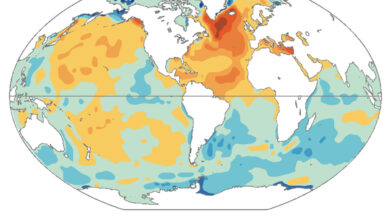Will China achieve its 2060 carbon neutral commitment from the provincial perspective? – Watts Up With That?

New paper in Advances in Climate Change Research
Li-LiSun a 1, Hui-JuanCui, a Quan-ShengGe b
a Key Laboratory of Land Surface Pattern and Simulation, Institute of Geographical Sciences and Natural Resources Research, Chinese Academy of Sciences, Beijing 100101, China
b University of Chinese Academy of Sciences, Beijing 100049, China
Received 19 August 2021, Revised 1 November 2021, Accepted 10 February 2022, Available online 16 February 2022, Version of Record 23 March 2022.
https://doi.org/10.1016/j.accre.2022.02.002 Get rights and content
Under a Creative Commons license Open access
Abstract
China has pledged to peak carbon emissions before 2030 and strive to achieve carbon neutrality before 2060. However, the significant variations of provincial carbon emissions make it unclear whether they can jointly fulfill the national carbon peak and neutrality goal. Thus, this study predicts the emission trajectories at provincial level in China by employing the extended STIRPAT (Stochastic Impacts by Regression on Population, Affluence, and Technology) model to see the feasibility and time of reaching peak carbon emissions and carbon neutrality. We found that most provinces can achieve peak emission before 2030 but challenging to achieve carbon neutrality before 2060, even considering the ecological carbon sink. The provincial neutrality time is concentrated between 2058 and 2070; the sooner the carbon emission peaks, the earlier the carbon neutral will be realized. The aggregated carbon emissions at provincial level show that China can achieve its carbon emission peak of 9.64–10.71 Gt before 2030, but it is unlikely to achieve the carbon neutrality goal before 2060 without carbon capture, utilization, and storage (CCUS). With high CCUS development, China is expected to achieve carbon neutrality in 2054–2058, irrespective of the socio-economic scenarios. With low CCUS development, China’s carbon neutrality target will be achieved only under the accelerated-improvement scenario, while it will postpone to 2061 and 2064 under the continued-improvement and the business-as-usual scenarios, respectively.
Keywords
China’s carbon neutralityPeak emissionProvincial emissionCCUSSTIRPAT
1. Introduction
In 2015, the Paris Agreement has set long-term temperature goals to control the global average warming at 2 °C and strive to limit it to 1.5 °C by the end of the 21st century. However, global greenhouse gas (GHG) emissions continued to grow and reach a record high of 52.4 Gt CO2e in 2019 without evidence of having peaked yet (BP, 2021). To meet the 2 °C temperature goal, all countries need to reduce additional GHG emissions of 12–19 Gt to their nationally determined contributions (NDCs) by 2030 and reach global CO2 emissions peak as soon as possible (UNEP, 2020). Besides, carbon neutrality by the mid-21st century is required to achieve the 1.5 °C goal (IPCC, 2018). Till now, many countries have started to make new pledges to carbon neutrality or zero-emission such as the European Union (EU), Japan, the Republic of Korea, Canada, etc., who have announced goals of carbon neutrality by 2050 (European Commission, 2018; NPR, 2020; Tradelink Publications, 2020 Canada Government, 2020).
China contributed 26% of global greenhouse gas emissions in 2019 (UNEP, 2020). As the first developing country to submit NDCs, the Chinese government committed to reaching peak CO2 emissions before 2030 and striving to achieve carbon neutrality before 2060 in September 2020 (The Chinese Foreign Ministry, 2020). According to Climate Action Tracker (CAT, 2020), if China achieves its announced goal of achieving carbon neutrality before 2060, it would lower global warming projections by around 0.2–0.3 °C, closer to the 1.5 °C warming limit of the Paris Agreement. Whether China can fulfill its carbon peak and neutral commitments is of great significance to the realization of the Paris Agreement. Compared with some developed countries whose emissions have peaked such as Canada, United Kingdom, and Japan, China’s carbon emissions are in a growth phase. The proposal of carbon neutrality by 2060 implies that China will have a shorter time to implement large-scale emission reduction after peaking around 2030 (Huang and Zhai, 2021). The timing of carbon emissions peak directly determines the available time and the amount of emission reduction to be completed from carbon peak to carbon neutrality (Hu, 2021). There is no doubt that achieving carbon neutrality in such a short period would be a great challenge for China and lack of lessons can be learned from the developed countries’ experiences (Yu et al., 2021). Therefore, the investigation into China’s peak and neutrality path would be of great importance to the world by providing a new possibility and could be informative for other developing countries, like India, whose GHG emission still rises and is highly likely to become the next largest emitters after China (Jiang et al., 2019). In that sense, it is of global significance to focus on China’s carbon peaking and carbon neutralization and to design a clear emission reduction roadmap as soon as possible, especially the provincial roadmap.
Confined by different population distribution, resource endowment, and socio-economic development, the reduction potential of carbon emissions vary considerably across China’s provinces (Zhang et al., 2020). More developed regions have lower energy intensities, higher energy efficiencies, and advanced emission reduction technology, facilitating an earlier peak of emissions (Li et al., 2017a, Li et al., 2017b; Du et al., 2017; Su et al., 2014). For example, As one of the low carbon pilot cities in China, Beijing has announced that its carbon emissions peak in 2020 (Cui et al., 2020). On the other hand, Guangdong, another developed province, will achieve peak CO2 emissions in 2020–2025 (Huang et al., 2013; Cheng et al., 2015) or is unlikely to peak before 2030 (Wang et al., 2019). Chongqing will achieve peak CO2 emissions by approximately 2030 (Liang et al., 2014) or shortly after that (Liu et al., 2017). Some undeveloped western provinces like Shanxi, Shaanxi, Xinjiang, and Inner Mongolia are expected to reach peak CO2 emissions between 2025 and 2035 (Dong et al., 2017; Li et al., 2017a, Li et al., 2017b; Zhou et al., 2016). The difference in the peak time of carbon emissions across provinces are noteworthy. Different research predicted highly variable peak times even for the same province, ranging from 2 to 14 years. Shi (2020) predicted the peak of CO2 emissions in Shandong and Hebei would occur by 2025. But, Wang et al. (2021) believed Shandong is probably to reach carbon peaks after 2030 and even to 2045 due to its high energy intensity and low renewable energy utilization, while Hebei is probably to peak before 2026 relying on geographical advantages (affected by advance low-carbon technology in Beijing). It is primarily attributed to applying different methods and selecting various socio-economic drivers behind carbon emissions (i.e., population, GDP per capita, and energy intensity). Besides, some emission reduction plans were sorted out in provincial 14th Five-Year Plan. For example, Beijing and Tianjin have formulated policies to accelerate the energy structure reform and promote clean and efficient utilization of energy.
The drivers of carbon emissions are detected mainly by decomposition analysis, IPAT (Impact, Population, Affluence, and Technology) model and STIRPAT (Stochastic Impacts by Regression on Population, Affluence, and Technology) model. The STIRPAT was created based on the IPAT model, and it abandons unit elasticity assumption and adds randomness to facilitate empirical analysis (Fang et al., 2019; Nguyen et al., 2019; Ghazali and Ali, 2019). Therefore, the STIRPAT model is ahead of the IPAT model for more factors are considered and integrated to analyze scenarios for emission trajectory simulation. It can help policymakers seek feasible emission reduction paths since comparative estimate factors can observe all the possible outcomes. The drivers usually include population, urbanization, economy level, energy intensity, industrial structure, and energy structure. It is found that urbanization level, economic level, and industry structure promote carbon emission, while energy intensity, technology progress, and tertiary industry proportion decrease CO2 emissions (Wang et al., 2012, 2017; Shen et al., 2018). Besides, it is found that the driving factors of carbon emissions various across regions, even various in the same region (Inglesi-Lotz, 2018). Therefore, considering significant differences in population, economy, and carbon emissions, it is necessary to explore the driving factors of carbon emissions at provincial level.
When and how Chinese provinces will reach carbon peak and carbon neutrally remain unclear from existing literatures. To close this gap, this study aims to explore whether China can achieve its peak carbon emissions target before 2030 and the carbon neutrality target before 2060 from the provincial perspective. To that end, the STIRPAT model was applied to investigate the carbon emission drivers in China’s 30 provinces during 1995–2017 and predict their future emissions from 2018 to 2080 under different scenarios to see whether and when each province will achieve peak emissions and carbon neutrality. Finally, China’s overall carbon peak and neutrality were assessed with CCUS.
….
5. Conclusions
This study predicts the carbon emission trajectories of 30 provinces by employing the extended STIRPAT model and explore if they can achieve China’s targets of attaining peak carbon emissions before 2030 and carbon neutrality before 2060. We found that the sooner the carbon emissions peak, the earlier the carbon neutrality will be realized. Under the BAU scenario, most provinces in Group I, Group II, and Group III can achieve their peak carbon emissions in 2023–2030 but are unlikely to achieve the carbon-neutrality targets before 2060. Under the CIS scenario, all provinces can reach peak carbon emissions in 2021–2030, but only eight provinces, including Beijing and Hainan, can achieve carbon neutrality before 2060. Under the AIS scenario, all provinces can reach peak carbon emissions in 2021–2030, and roughly half of the provinces are expected to achieve carbon neutrality by 2060.
China can achieve its carbon emission peak of 9.64–10.71 Gt regardless of the scenarios before 2030. However, it would be hard to achieve its neutrality goal before 2060 without CCUS, where additional carbon reduction or negative emission of 519–2631 Mt is needed. With the low CCUS development, China is likely to achieve its carbon neutrality target only under the AIS. In contrast, with the high CCUS development, China can achieve its neutrality target regardless of the scenario, with the neutrality times being around 2058 (BAU), 2056 (CIS), and 2054 (AIS).
Significant variations found in carbon reduction ratio, peak time, and neutral time in provinces suggest that socio-economic disparities should be considered when formulating targeted mitigation policies. For provinces like Beijing and Shanghai that would achieve carbon emission peak and carbon neutrality targets under one and two scenarios, improving the energy intensity is the key to quicken peak carbon emission and carbon neutrality time. For provinces like Shandong and Chongqing that would achieve peak carbon emissions but are unlikely to achieve carbon neutrality targets under one and two scenarios, it is necessary to adjust the energy consumption structure for achieving the carbon reduction target as soon as possible. For provinces like Inner Mongolia, Anhui, and Hebei that would neither achieve carbon emission peak nor the carbon-neutrality target under at least one and two scenarios, it is crucial to change the economic development pattern, control urbanization growth rate, and formulate stricter environmental regulations. Furthermore, given the contribution of CCUS to China’s carbon neutrality target before 2060, it is imperative to develop CCUS technology vigorously and design an appropriate roadmap of the CCUS strategy as soon as possible.




